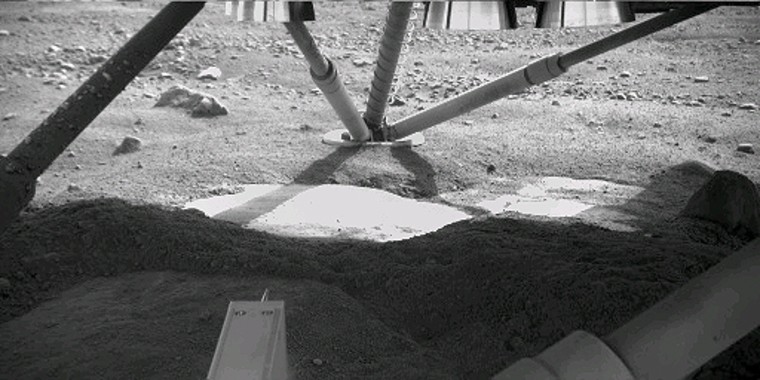NASA's Phoenix Mars Lander sent back images of the blind spot underneath it on Friday — perhaps revealing Martian ice for the first time up close — as the mission team geared up for the craft's robotic arm to touch the planet's soil for the first time.
The spacecraft also encountered a short circuit in one of its instruments, mission scientists said at a briefing on Friday.
Phoenix's robotic arm was maneuvered so that the camera at the end of it could image the space underneath the lander, which is a blind spot for the stereo camera on top of the lander's deck. The images showed some interesting tabular formations, said Ray Arvidson of Washington University in St. Louis, a co-investigator for the robotic arm experiment.
"We don't know what they are. They could be exposures of ice, or they could be exposures of rocks," Arvidson said at a briefing here at the University of Arizona. "We're really pushing for ice, but we don't know if that's the case yet."
The $420 million Phoenix mission is designed to dig down to the layers of water ice thought to lie just under the surface of Mars' north polar region, where it landed on Sunday. Instruments on the spacecraft are designed to analyze soil samples to see if the ice was once liquid and could have created a habitable zone for microbial life at some point in Mars' past.
Mission controllers have encountered a problem with one of these instruments, the Thermal and Evolved-Gas Analyzer. The TEGA instrument is designed to heat up soil samples until vapors come off, and then analyze those vapors to detect the composition of the soil.
The glitch seems to be a short circuit in a filament in a part of the instrument that ionizes the vapors before they are sent to the detector, said TEGA co-investigator William Boynton of the University of Arizona. There are two filaments in the detector, however, and scientists are now investigating whether they can operate the instrument with just the one filament. They will also being sending up diagnostic instructions over the next few days.
"We're quite optimistic that we have a workaround that will let us operate the instrument," Boynton said.
Meanwhile, mission scientists are also gathering more information about the soil near the lander so that they can begin digging for samples. The first step will be imaging all three of the lander's footpads with the robotic arm camera to make sure the craft is stable on the ground, mission scientists said.
After that, mission scientists plan to perform a "soil touch," which involves moving the scoop at the end of the robotic arm and making a dent in the soil, then turning the scoop around and imaging the dent to make sure that controllers know how to reach the soil, Arvidson told Space.com.
The next step will be to do what mission scientists call a "dig and dump," an exercise in having the robotic arm scoop up the soil and dump it down again.
Mission controllers are waiting to get data back from Phoenix's Friday night downlink on one of the proposed "dig and dump" sites to decide when and where to perform the soil touch maneuver.
